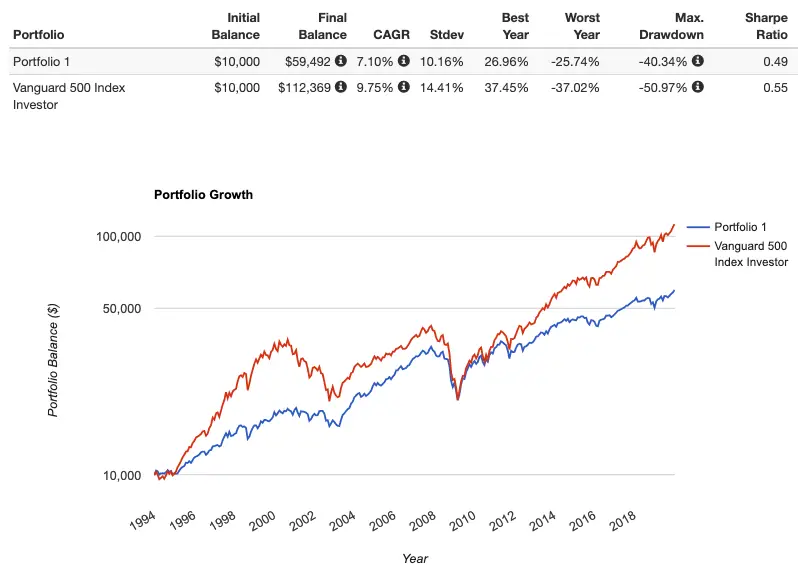The Frank Armstrong Ideal Index Portfolio is comprised of global stocks, short term bonds, and REITs. Here we’ll take a look at its components, performance, and the best ETF’s to use in its implementation.
Interested in more Lazy Portfolios? See the full list here.
Disclosure: Some of the links on this page are referral links. At no additional cost to you, if you choose to make a purchase or sign up for a service after clicking through those links, I may receive a small commission. This allows me to continue producing high-quality content on this site and pays for the occasional cup of coffee. I have first-hand experience with every product or service I recommend, and I recommend them because I genuinely believe they are useful, not because of the commission I may get. Read more here.
Contents
Who is Frank Armstrong?
As the name suggests, the Ideal Index Portfolio was created by financial adviser and author Frank Armstrong. Armstrong is a Certified Financial Planner and the founder of Investor Solutions, Inc. You can find his books on Amazon here.
What is the Frank Armstrong Ideal Index Portfolio?
The 5 Asset Portfolio is globally diversified across stocks and bonds and includes dedicated diversifiers like commodities and REITs in an attempt to lower the portfolio's volatility and risk. The Frank Armstrong Ideal Index Portfolio is as follows:
- 31% International Large Cap Stocks
- 9.25% U.S. Small Cap Value
- 9.25% U.S. Large Cap Value
- 8% U.S. REITs
- 6.25% U.S. Small Cap Growth
- 6.25% U.S. Large Cap
- 30% U.S. Short-Term Bonds
Frank Armstrong Ideal Index Portfolio Performance Backtest vs. the S&P 500
With my REIT data only going back to 1994, here's the Frank Armstrong Ideal Index Portfolio's performance vs. an S&P 500 index fund through 2019:

With international stocks, small cap stocks, and the Value factor suffering recently, and with REITs taking a dive in the 2008 Global Financial Crisis, the Ideal Index Portfolio has delivered a lower risk-adjusted return (Sharpe) than the S&P 500 over this time period, with volatility only about 1/3 lower.
I believe the Value premium still exists. Clearly Armstrong does too. But that makes the dedicated inclusion of small-cap growth stocks questionable and confusing, as small-cap growth stocks have demonstrably not paid a risk premium historically. I can appreciate the dedicated inclusion of REITs and international stocks, but I also feel that a 30% allocation to a cash equivalent is far too conservative for my tastes, and won't provide the diversification benefit that longer-duration bonds would.
Frank Armstrong Ideal Index Portfolio ETF Pie for M1 Finance
M1 Finance is a great choice of broker to implement the 5 Asset Portfolio because it makes regular rebalancing seamless and easy, has zero transaction fees, and incorporates dynamic rebalancing for new deposits. I wrote a comprehensive review of M1 Finance here.
Note that M1 Finance does not allow for fractions of 1% holdings on the first buy, so I've slightly adjusted the allocations.
Using entirely low-cost Vanguard funds, we can construct the Ideal Index Portfolio pie like this:
- VXUS – 31%
- VBR – 9%
- VTV – 9%
- VNQ – 8%
- VBK – 6%
- VOO – 7%
- VGSH – 30%
You can add the Ideal Index Portfolio pie to your portfolio on M1 Finance by clicking this link and then clicking “Invest in this pie.”
Disclosure: I am long VOO, VBR, and VXUS.
Interested in more Lazy Portfolios? See the full list here.
Disclaimer: While I love diving into investing-related data and playing around with backtests, this is not financial advice, investing advice, or tax advice. The information on this website is for informational, educational, and entertainment purposes only. Investment products discussed (ETFs, mutual funds, etc.) are for illustrative purposes only. It is not a research report. It is not a recommendation to buy, sell, or otherwise transact in any of the products mentioned. I always attempt to ensure the accuracy of information presented but that accuracy cannot be guaranteed. Do your own due diligence. I mention M1 Finance a lot around here. M1 does not provide investment advice, and this is not an offer or solicitation of an offer, or advice to buy or sell any security, and you are encouraged to consult your personal investment, legal, and tax advisors. Hypothetical examples used, such as historical backtests, do not reflect any specific investments, are for illustrative purposes only, and should not be considered an offer to buy or sell any products. All investing involves risk, including the risk of losing the money you invest. Past performance does not guarantee future results. Opinions are my own and do not represent those of other parties mentioned. Read my lengthier disclaimer here.

Are you nearing or in retirement? Use my link here to get a free holistic financial plan and to take advantage of 25% exclusive savings on financial planning and wealth management services from fiduciary advisors at Retirable to manage your savings, spend smarter, and navigate key decisions.


Leave a Reply